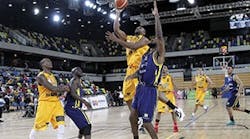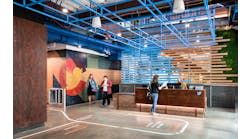Daylighting is a desirable feature for a building, but it is often considered unfeasible due to the expensive retrofits that it might require. The interior sections of a building, for example, are often left without any natural light post-retrofit and still require consistent conventional lighting, which causes the energy bill to remain high.
Tubular daylighting devices (TDDs) – sometimes referred to as light tubes or light pipes – provide an option for FMs looking to incorporate daylighting into buildings from the roof without installing large windows.
“TDDs may be used in any building type to daylight interior spaces directly under roofs,” says Dr. Abdelaziz Laouadi, Research Officer at the National Research Council Canada. “Of particular importance are low-rise buildings where lighting energy constitutes a significant portion of the electrical energy use.”
TDDs are comprised of three parts: a collector on the roof that gathers sunlight, a hollow pipe guide that channels the light down and a diffuser at the ceiling that spreads light throughout the interior of the building. Installation typically takes little time, but you will want to be aware of the layout and topography of your roof before you install them.
“TDD layout on roofs should be coordinated with other roof-mounted systems such as HVAC systems and solar panels to avoid any potential solar shading on TDDs, as well as ceiling mounted systems like luminaires, HVAC elements, and roof structural trusses to avoid blocking TDD lights from reaching interior spaces,” explains Laouadi. Other logistical considerations to take include identifying the number of devices you might install and how closely you should space them out to ensure the best indoor illumination.
The type of collector used can have a major effect on the lighting power output, according to Laouadi. Using prisms, reflectors or other optical components, some TDDs can collect daylight when the sun is at a low altitude, including early mornings, late evenings and winter days. They can also redirect the light to reduce reflection losses in the pipe. Others that have plain domes will not be as effective at low solar altitude times.
Many FMs lament solar heat gain from conventional skylights. However, Laouadi notes, “TDD products provide daylight with a significantly lower amount of solar heat gain to buildings. Most commercially available TDDs have a medium to low solar heat gain coefficient (SHGC).” The small quantity of roof area on commercial buildings covered with skylights with this solution, low SHGC and the reduction of electrical lighting heat gains due to daylighting minimize total heat gain. The resulting net energy use will be dependent on the building site and local climate. But before you install TDDs, make sure you live in the right climate.
“Most TDDs are many times more efficient in collecting direct beam sunlight on clear or partly cloudy days with visible sun than on overcast days,” says Laouadi. “TDDs are better suited for building locations with minimum annual occurrences of overcast sky conditions compared to clear and partly cloudy sky conditions.”
Justin Feit [email protected] is assistant editor of BUILDINGS.
Tubular Daylighting Device Performance Indicators
If you are considering TDDs for your building, consider some key indicators of performance before purchasing. Dr. Abdelaziz Laouadi, Research Officer at the National Research Council Canada, explains that the following four indicators are the most important factors in a TDD’s performance.
1) Visible (or Light) Transmittance (VT): Higher VT ratings will ultimately be better, with typical VT values of current products ranging from 0.15 to 0.55.
2) Spacing to mounting height ratio (SR): “The higher the SR, the better to minimize the capital cost of TDDs,” explains Laouadi. “However, the SR should not infringe on the applicable building fire code requirement for skylight spacing. For ideally diffusing TDDs, the SR varies from 1 to 1.5 to provide acceptable illuminance uniformity on horizontal work planes.”
3) U-factor: Lower U-factors (inverse of thermal resistance) will more effectively reduce heat loss in climates that require more heating. Multi-plane collectors work best when insulation is placed at roof level in commercial buildings. Typically, U-factors (in Btu/h•ft2•degrees F.) range from 1.39 (R-0.72) to 0.37 (R-2.7).
4) Solar Heat Gain Coefficient (SHGC): For climates that require a lot of heating, TDDs should have a medium to high SHGC. But most TDDs have a medium to low SHGC (<0.45).


